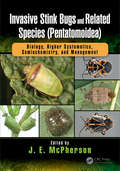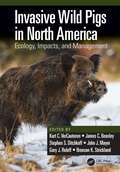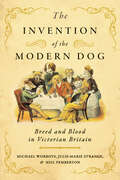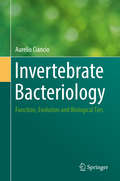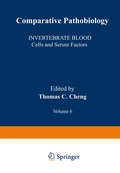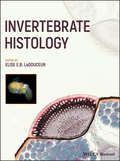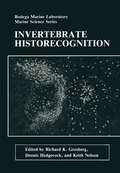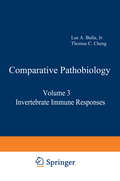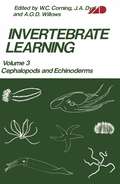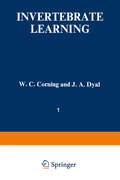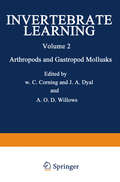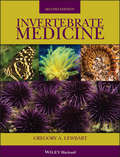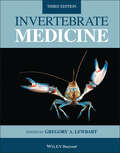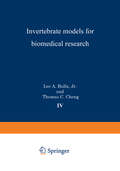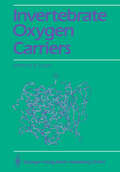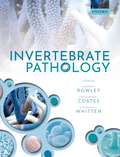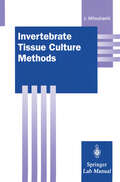- Table View
- List View
Invasive Stink Bugs and Related Species: Biology, Higher Systematics, Semiochemistry, and Management (Contemporary Topics in Entomology)
by J. E. McPhersonKey features: Presents a brief history of past classifications, a summary of present classification, and speculation on how the classification may evolve in the future Includes keys for the identification of families and subfamilies of the Pentatomoidea and for the tribes in the Pentatomidae Explains transmission of plant pathogens and concepts of pathology and heteropteran feeding for the non-specialist Provides an extensive literature review of transmission by stink bugs of viral, bacterial, fungal, and protozoan organisms that cause diseases of plants Discusses the diversity of microbial symbionts in the Pentatomidae and related species, showing how microorganisms underpin the evolution of this insect group Reviews semiochemicals (pheromones, kairomones, allomones) of the Pentatomoidea and their vital role in the life histories of pest and beneficial species and their exploitation by natural enemies of true bugs Covers past, current, and future control options for insects, with a focus on stink bugs and related heteropterans The Superfamily Pentatomoidea (stink bugs and their relatives) is comprised of 18 families with over 8,000 species, the largest of which is the family Pentatomidae (about 5,000 species). These species primarily are phytophagous, and many cause tremendous economic damage to crops worldwide. Within this superfamily are six invasive species, two that occur worldwide and four that are recent invaders in North America. Once established in new geographic regions, these species have increased their numbers and geographic distributions dramatically, causing economic damage totaling billions of dollars. Invasive Stink Bugs and Related Species (Pentatomoidea): Biology, Higher Systematics, Semiochemistry, and Management is the first book that presents comprehensive coverage of the biology of invasive pentatomoids and related true bug species and addresses issues of rapidly growing economic and environmental concerns. Containing the contributions of more than 60 stink bug specialists from 15 countries, this book provides a better understanding of the biology and economic importance of these invasive species, why they became invasive, and how their continued geographical expansion is likely to affect numerous agricultural systems and natural environments. Including over 3,500 references, this authoritative work serves as an access point to the primary literature on their life histories, higher systematics, diapause and seasonal cycles, pathogens, symbionts, semiochemistry, and pest management control strategies for pentatomoid bugs.
Invasive Stink Bugs and Related Species: Biology, Higher Systematics, Semiochemistry, and Management (Contemporary Topics in Entomology)
by J. E. McPhersonKey features: Presents a brief history of past classifications, a summary of present classification, and speculation on how the classification may evolve in the future Includes keys for the identification of families and subfamilies of the Pentatomoidea and for the tribes in the Pentatomidae Explains transmission of plant pathogens and concepts of pathology and heteropteran feeding for the non-specialist Provides an extensive literature review of transmission by stink bugs of viral, bacterial, fungal, and protozoan organisms that cause diseases of plants Discusses the diversity of microbial symbionts in the Pentatomidae and related species, showing how microorganisms underpin the evolution of this insect group Reviews semiochemicals (pheromones, kairomones, allomones) of the Pentatomoidea and their vital role in the life histories of pest and beneficial species and their exploitation by natural enemies of true bugs Covers past, current, and future control options for insects, with a focus on stink bugs and related heteropterans The Superfamily Pentatomoidea (stink bugs and their relatives) is comprised of 18 families with over 8,000 species, the largest of which is the family Pentatomidae (about 5,000 species). These species primarily are phytophagous, and many cause tremendous economic damage to crops worldwide. Within this superfamily are six invasive species, two that occur worldwide and four that are recent invaders in North America. Once established in new geographic regions, these species have increased their numbers and geographic distributions dramatically, causing economic damage totaling billions of dollars. Invasive Stink Bugs and Related Species (Pentatomoidea): Biology, Higher Systematics, Semiochemistry, and Management is the first book that presents comprehensive coverage of the biology of invasive pentatomoids and related true bug species and addresses issues of rapidly growing economic and environmental concerns. Containing the contributions of more than 60 stink bug specialists from 15 countries, this book provides a better understanding of the biology and economic importance of these invasive species, why they became invasive, and how their continued geographical expansion is likely to affect numerous agricultural systems and natural environments. Including over 3,500 references, this authoritative work serves as an access point to the primary literature on their life histories, higher systematics, diapause and seasonal cycles, pathogens, symbionts, semiochemistry, and pest management control strategies for pentatomoid bugs.
Invasive Wild Pigs in North America: Ecology, Impacts, and Management
by Kurt VerCauteren James Beasley Stephen S. Ditchkoff John J. Mayer Gary J. Roloff Bronson K. StricklandThroughout North America, non-native wild pigs have become an ecologically and economically destructive invasive species. Though they are regarded as a popular game species by some, provide economic benefits to others, and are even engrained into societal heritage in some areas, wild pigs are responsible for an extraordinary amount of damage in both natural and anthropogenic systems throughout North America. As the density and range of wild pig habitat have substantially increased over the last several decades, the magnitude and diversity of their negative impacts are not yet fully realized or quantified. With various conflicts continually emerging, wild pig management is difficult and expensive to achieve. As a result, wild pigs represent one of the greatest wildlife management challenges North America faces in the 21st century. Invasive Wild Pigs in North America: Ecology, Impacts, and Management addresses all aspects of wild pig biology, ecology, damage, and management in a single comprehensive volume. It assimilates and organizes information on the most destructive introduced vertebrate species in the United States, establishing a foundation from which managers, researchers, policy makers, and other stakeholders can build upon into the future. The book provides comprehensive coverage of wild pig biology and ecology, techniques for management and research, and regional chapters. It is an asset to readers interested in wild pigs, the resources they impact, and how to mitigate those impacts, and establishes a vision of the future of wild pigs in North America. Features: Compiles valuable knowledge for a broad audience including wild pig managers, researchers, adversaries, and enthusiasts from across North America Addresses taxonomy, morphology, genetics, physiology, spatial ecology, population dynamics, diseases and parasites, and the naturalized niche of wild pigs Includes chapters on damage to resources, management, research methods, human dimensions and education, and policy and legislation Contains full color images and case studies of interesting and informative situations being created by wild pigs throughout North America Includes a chapter on wild pigs at the wildland–urban interface, a more recent and especially challenging issue
Invasive Wild Pigs in North America: Ecology, Impacts, and Management
by Kurt C. VerCauteren James C. Beasley Stephen S. Ditchkoff John J. Mayer Gary J. Roloff Bronson K. StricklandThroughout North America, non-native wild pigs have become an ecologically and economically destructive invasive species. Though they are regarded as a popular game species by some, provide economic benefits to others, and are even engrained into societal heritage in some areas, wild pigs are responsible for an extraordinary amount of damage in both natural and anthropogenic systems throughout North America. As the density and range of wild pig habitat have substantially increased over the last several decades, the magnitude and diversity of their negative impacts are not yet fully realized or quantified. With various conflicts continually emerging, wild pig management is difficult and expensive to achieve. As a result, wild pigs represent one of the greatest wildlife management challenges North America faces in the 21st century. Invasive Wild Pigs in North America: Ecology, Impacts, and Management addresses all aspects of wild pig biology, ecology, damage, and management in a single comprehensive volume. It assimilates and organizes information on the most destructive introduced vertebrate species in the United States, establishing a foundation from which managers, researchers, policy makers, and other stakeholders can build upon into the future. The book provides comprehensive coverage of wild pig biology and ecology, techniques for management and research, and regional chapters. It is an asset to readers interested in wild pigs, the resources they impact, and how to mitigate those impacts, and establishes a vision of the future of wild pigs in North America. Features: Compiles valuable knowledge for a broad audience including wild pig managers, researchers, adversaries, and enthusiasts from across North America Addresses taxonomy, morphology, genetics, physiology, spatial ecology, population dynamics, diseases and parasites, and the naturalized niche of wild pigs Includes chapters on damage to resources, management, research methods, human dimensions and education, and policy and legislation Contains full color images and case studies of interesting and informative situations being created by wild pigs throughout North America Includes a chapter on wild pigs at the wildland–urban interface, a more recent and especially challenging issue
The Invention of the Modern Dog: Breed and Blood in Victorian Britain (Animals, History, Culture)
by Michael Worboys Julie-Marie Strange Neil PembertonFor centuries, different types of dogs were bred around the world for work, sport, or companionship. But it was not until Victorian times that breeders started to produce discrete, differentiated, standardized breeds. In The Invention of the Modern Dog, Michael Worboys, Julie-Marie Strange, and Neil Pemberton explore when, where, why, and how Victorians invented the modern way of ordering and breeding dogs. Though talk of "breed" was common before this period in the context of livestock, the modern idea of a dog breed defined in terms of shape, size, coat, and color arose during the Victorian period in response to a burgeoning competitive dog show culture. The authors explain how breeders, exhibitors, and showmen borrowed ideas of inheritance and pure blood, as well as breeding practices of livestock, horse, poultry and other fancy breeders, and applied them to a species that was long thought about solely in terms of work and companionship.The new dog breeds embodied and reflected key aspects of Victorian culture, and they quickly spread across the world, as some of Britain;€™s top dogs were taken on stud tours or exported in a growing international trade. Connecting the emergence and development of certain dog breeds to both scientific understandings of race and blood as well as Britain;€™s posture in a global empire, The Invention of the Modern Dog demonstrates that studying dog breeding cultures allows historians to better understand the complex social relationships of late-nineteenth-century Britain.
The Invention of the Modern Dog: Breed and Blood in Victorian Britain (Animals, History, Culture)
by Michael Worboys Julie-Marie Strange Neil PembertonFor centuries, different types of dogs were bred around the world for work, sport, or companionship. But it was not until Victorian times that breeders started to produce discrete, differentiated, standardized breeds. In The Invention of the Modern Dog, Michael Worboys, Julie-Marie Strange, and Neil Pemberton explore when, where, why, and how Victorians invented the modern way of ordering and breeding dogs. Though talk of "breed" was common before this period in the context of livestock, the modern idea of a dog breed defined in terms of shape, size, coat, and color arose during the Victorian period in response to a burgeoning competitive dog show culture. The authors explain how breeders, exhibitors, and showmen borrowed ideas of inheritance and pure blood, as well as breeding practices of livestock, horse, poultry and other fancy breeders, and applied them to a species that was long thought about solely in terms of work and companionship.The new dog breeds embodied and reflected key aspects of Victorian culture, and they quickly spread across the world, as some of Britain;€™s top dogs were taken on stud tours or exported in a growing international trade. Connecting the emergence and development of certain dog breeds to both scientific understandings of race and blood as well as Britain;€™s posture in a global empire, The Invention of the Modern Dog demonstrates that studying dog breeding cultures allows historians to better understand the complex social relationships of late-nineteenth-century Britain.
Inventory Management for Veterinary Professionals
by Nicole I. ClausenImplement an effective and efficient inventory management system in your veterinary practice using this practical and concrete guidance Inventory Management for Veterinary Professionals provides a thorough introduction to the logistics of effective and efficient veterinary inventory management. Designed for any employee of a veterinary practice, the book covers strategies and tactics for all major aspects of inventory management. It provides veterinary professionals with a practical roadmap for this key business operation, with stories drawing on the author’s experience to provide a real-world perspective. Emphasizing both the ‘how’ and the ‘why’ of developing effective inventory management systems, it’s an indispensable tool for veterinary professionals at every level of practice. Taking a holistic approach to setting up, maintaining, and optimizing an inventory system, the book begins by describing the theory and strategies for inventory management, then discusses how to incorporate this knowledge into practice. Inventory Management for Veterinary Professionals offers: Detailed discussion of topics including the flow of inventory through the practice, forecasting, ordering, troubleshooting, and moreAdvice on how to receive and restock, organize, price, and sell inventoryGuidance on how to set up an inventory action planA chapter on setting and executing inventory management protocols around controlled substancesA companion website with additional tools, resources, and self-assessment questions Inventory Management for Veterinary Professionals is ideal for any veterinary professional, including practice managers, receptionists, assistants, technicians, and practice owners.
Inventory Management for Veterinary Professionals
by Nicole I. ClausenImplement an effective and efficient inventory management system in your veterinary practice using this practical and concrete guidance Inventory Management for Veterinary Professionals provides a thorough introduction to the logistics of effective and efficient veterinary inventory management. Designed for any employee of a veterinary practice, the book covers strategies and tactics for all major aspects of inventory management. It provides veterinary professionals with a practical roadmap for this key business operation, with stories drawing on the author’s experience to provide a real-world perspective. Emphasizing both the ‘how’ and the ‘why’ of developing effective inventory management systems, it’s an indispensable tool for veterinary professionals at every level of practice. Taking a holistic approach to setting up, maintaining, and optimizing an inventory system, the book begins by describing the theory and strategies for inventory management, then discusses how to incorporate this knowledge into practice. Inventory Management for Veterinary Professionals offers: Detailed discussion of topics including the flow of inventory through the practice, forecasting, ordering, troubleshooting, and moreAdvice on how to receive and restock, organize, price, and sell inventoryGuidance on how to set up an inventory action planA chapter on setting and executing inventory management protocols around controlled substancesA companion website with additional tools, resources, and self-assessment questions Inventory Management for Veterinary Professionals is ideal for any veterinary professional, including practice managers, receptionists, assistants, technicians, and practice owners.
Invertebrate Bacteriology: Function, Evolution and Biological Ties (Sustainability In Plant And Crop Protection Ser.)
by Aurelio CiancioThis compendium reviews different processes acting on bacterial groups that evolved one or more relationships with members of the most important invertebrate Phyla. Starting from principles of basic bacteriology the book provides data on bacteria interactions with pests, animal or human diseases. Being present in all environments, from deep see to crops, animals or plants, invertebrates represent the most significant and ancient fraction of the eukaryotic biomass on earth. Their evolutive adaptations and links with bacteria, established over time scales of ages, range from vectored diseases to speciation, within a wide range of environmental niches and biocenosis, including oceanic hydrothermal vents. Main functional processes include pathogenicity, parasitism, transmission, immunity, symbiosis and speciation. A review about recent advances achieved in these research topics is given, focussing on one or more aspects concerning significant evolutive paths of bacteria and underlying functional links. Rather than proceeding through the order and structure of taxonomies, the volume is organized by processes, examining their functional role in different lineages, including but not limited to insects or nematodes. Processes involved in parasitism focus, at a finer level, on examples from many taxa. Molecular aspects underpinning these and other functional processes include the effects of horizontal gene transfer, the mechanisms active in immune defense and vectoring, and the antibacterial peptides. Finally, the effects of climate warming, biological invasions and agriculture are examined, with particular attention to farming and environment.
Invertebrate Blood: Cells and Serum Factors (Comparative Pathobiology #6)
by Thomas C. ChengAt a recent meeting of the Society for Invertebrate Pathology, Dr. K. Kanungo of Western Connecticut State University organized a special symposium on the topic of invertebrate circulatory systems with emphasis on hemocytes and their role in internal defense. The contents of this volume of Comparative Pathobiology represent the proceedings of that gathering. As the Editor of the Journal of Invertebrate Pathology, I am intimately aware of the current popularity of research pertaining to invertebrate immune mechanisms of which hemocytes and associated molecules play a central role. Consequently, the contributions in cluded herein should prove to be of interest to a variety of investi gators including invertebrate zoologists, comparative immunolo gists, physiologists, and cell biologists. As has been stated in previous volumes of this series, Comparative Pathobiology is meant for the publication of proceedings of symposia devoted to some aspect of that broad spectrum of modern biology known as pathobiology. Those interested in having antici pated contributions considered for publication should contact me.
Invertebrate Histology
by Elise E.B. LaDouceurThe first comprehensive reference to invertebrate histology Invertebrate Histology is a groundbreaking text that offers a comprehensive review of histology in invertebrates. Designed for use by anyone studying, diagnosing, or researching invertebrates, the book covers all major taxonomic groups with details of the histologic features, with color photographs and drawings that clearly demonstrate gross anatomy and histology. The authors, who are each experts in the histology of their respective taxa, bring together the most recent information on the topic into a single, complete volume. An accessible resource, each chapter focuses on a single taxonomic group with salient gross and histologic features that are clearly described in the text and augmented with color photographs and greyscale line drawings. The histologic images are from mostly hematoxylin and eosin stained microscopic slides showing various organ systems at high and low magnification. In addition, each chapter provides helpful tips for invertebrate dissection and information on how to process invertebrates for histology. This important book: Presents detailed information on histology of all major groups of invertebrates Offers a user-friendly text that is organized by taxonomic group for easy reference Features high-quality color photographs and drawings, with slides showing histology and gross photographs to demonstrate anatomy Provides details on invertebrate dissection and processing invertebrates for histology Written for veterinary pathologists, biologists, zoologists, students, and other scientists studying these species, Invertebrate Histology offers the most updated information on the topic written by over 20 experts in the field.
Invertebrate Histology
by Elise E. B. LaDouceurThe first comprehensive reference to invertebrate histology Invertebrate Histology is a groundbreaking text that offers a comprehensive review of histology in invertebrates. Designed for use by anyone studying, diagnosing, or researching invertebrates, the book covers all major taxonomic groups with details of the histologic features, with color photographs and drawings that clearly demonstrate gross anatomy and histology. The authors, who are each experts in the histology of their respective taxa, bring together the most recent information on the topic into a single, complete volume. An accessible resource, each chapter focuses on a single taxonomic group with salient gross and histologic features that are clearly described in the text and augmented with color photographs and greyscale line drawings. The histologic images are from mostly hematoxylin and eosin stained microscopic slides showing various organ systems at high and low magnification. In addition, each chapter provides helpful tips for invertebrate dissection and information on how to process invertebrates for histology. This important book: Presents detailed information on histology of all major groups of invertebrates Offers a user-friendly text that is organized by taxonomic group for easy reference Features high-quality color photographs and drawings, with slides showing histology and gross photographs to demonstrate anatomy Provides details on invertebrate dissection and processing invertebrates for histology Written for veterinary pathologists, biologists, zoologists, students, and other scientists studying these species, Invertebrate Histology offers the most updated information on the topic written by over 20 experts in the field.
Invertebrate Historecognition (Bodega Marine Laboratory Marine Science Series)
by Richard K. Grosberg Dennis Hedgecock Keith NelsonHistorecognition, broadly defined, spans the processes responsible for the regulation of the genetic integrity of self in the face of conspecific (allogeneic) and heterospecific (xenogeneic) nonself. The existence of precise historecognition systems in the invertebrates can be traced back to Bancroft's discovery in 1903 of ,strain specific regulation of colony fusion in the compound ascidian Botryllus schlosseri, and Wilson's report in 1907 of species-specific sponge re-aggregation. Despite this provocative history, invertebrate historecognition remained largely unexplored for over half a century, while studies of vertebrate immune systems prospered. Then, in the 1970's, interest in invertebrate his tore cognition grew once again, this time cast largely in terms of understanding the mechanisms and evolutionary history of vertebrate immunity. From our current understanding of vertebrate immunity and invertebrate historecognition, three generalizations about their relationships can be drawn. First, despite substantial knowledge about the genetics and molecular biology of cell recognition in the context of vertebrate immunity and to a lesser extent of invertebrate historecognition, the evolutionary relationships between invertebrate self/nonself recognition and vertebrate immune systems remain obscure. Second, although vertebrate allograft recognition is of dubious functional significance itself (because intergenotypic cellular contacts are unusual, except during fertilization and pregnancy), natural allografts occur frequently as sedentary invertebrates grow and compete for living space. It is now known that the operation of invertebrate his tore cognition systems can profoundly affect the outcomes of competitive interactions by mediating allogeneic aggressive behavior and somatic fusion.
Invertebrate Immune Responses (Comparative Pathobiology #3)
by Lee A. Bulla Jr. Thomas C. ChengThis represents the third volume of the series entitled Comparative PathobioZogy. The chapters included represent the proceedings of a symposium held at Oregon State University, Corvallis, on August 16-22, 1975. The symposium was co-sponsored by the Society for Invertebrate Pathology (SIP) and the American Society of Zoologists (ASZ). In recent years there has been an impressive increase in interest in comparative immunology, i. e. , a comparative approach to understanding how animals, both vertebrates and invertebrates, defend themselves against nonself materials. Ever since Metchnikoff's pioneering studies during the late l800s on the role of phagocytes of invertebrates, which led to his theory of cellular immunity, invertebrates have been employed with increasing fre quency for studying cellular defense. Consequently, it is not surprising that included in the memberships of SIP and ASZ are a large number of individuals with an active interest in this area of research. As indicated by the chapters included in this volume, the animal models employed have been primarily molluscs and insects, although crustaceans and annelids have also been popular.
Invertebrate Justice: Extending The Boundaries of Non-Speciesist Green Criminology (Palgrave Studies in Green Criminology)
by Russil DurrantInvertebrates are the neglected majority of the animal world. Even though they make up over 95% of animal life, they rarely feature in discussions of speciesism, animal ethics or species justice. This book aims to extend the work of non-speciesist criminologists to argue for the idea of ‘invertebrate justice’. Utilizing green criminologist Rob White’s (2013) eco-justice perspective, the book demonstrates how our interactions with invertebrate species (insects, crustaceans, molluscs and so forth) cause a significant amount of harm to those animals themselves (species justice), the ecosystems in which they are embedded (ecological justice), and ultimately to humans (environmental justice). Across three sections, it provides an overview of the ways in which humans and invertebrates interact across a diverse range of contexts and reviews the literature on both invertebrate biodiversity and invertebrate sentience; builds a theoretical framework that can help us understand what invertebrate justice might mean; and tackles the difficult question of how best we can promote invertebrate justice in the future. It appeals to academics, environmental scientists, activists and policymakers.
Invertebrate Learning: Volume 3 Cephalopods and Echinoderms
by W. C. Corning J. A. Dyal A. O. WillowsInvertebrate Learning: Volume 1 Protozoans Through Annelids
by William CorningSince the publication of the second volume of Comparative Psychology by Warden, Warner, and Jenkins (1940), there has not been a comprehensive review of invertebrate learning capacities. Some high-quality reviews have appeared in various journals, texts, and symposia, but they have been, of necessity, incomplete and selective either in terms of the phyla covered or the phenomena which were reviewed. Although this lack has served as a stimulus for the present series, the primary justification is to be found in the resurgence of theoretical and empirical interests in learning capacities and mechanisms in simpler systems of widely different phylogenetic origin. Intensive research on the physiological basis of learning and memory clearly entails exploration of the correlations between levels of nervous system organization and be havioral plasticity. Furthermore, the presence of structural-functional differ entiation in ganglionated systems, the existence of giant, easily identifiable cells, and the reduced complexity of structure and behavior repertoires are among the advantages of the "simple systems" strategy which have caused many neuroscientists to abandon their cats, rats, and monkeys in favor of mollusks, leeches, planaria, crayfish, protozoa, and other invertebrate preparations. Behavioral research continues to reveal remarkable capacities in these simple organisms and encourages us to believe that the confluence of the invertebrate learning data with the more voluminous vertebrate litera ture will contribute substantially to the enrichment of all of the neurobe havioral sciences.
Invertebrate Medicine
by Gregory A. LewbartInvertebrate Medicine, Second Edition offers a thorough update to the most comprehensive book on invertebrate husbandry and veterinary care. Including pertinent biological data for invertebrate species, the book’s emphasis is on providing state-of-the-art information on medicine and the clinical condition. Invertebrate Medicine, Second Edition is an invaluable guide to the medical care of both captive and wild invertebrate animals. Coverage includes sponges, jellyfish, anemones, corals, mollusks, starfish, sea urchins, crabs, crayfish, lobsters, shrimp, hermit crabs, spiders, scorpions, and many more, with chapters organized by taxonomy. New chapters provide information on reef systems, honeybees, butterfly houses, conservation, welfare, and sources of invertebrates and supplies. Invertebrate Medicine, Second Edition is an essential resource for veterinarians in zoo animal, exotic animal and laboratory animal medicine; public and private aquarists; and aquaculturists.
Invertebrate Medicine
by Gregory A. LewbartPresented in full color for the first time, Invertebrate Medicine is the definitive resource on husbandry and veterinary medicine in invertebrate species. Presenting authoritative information applicable to both in-human care and wild invertebrates, this comprehensive volume addresses the medical care and clinical condition of most important invertebrate species—providing biological data for sponges, jellyfish, anemones, snails, sea hares, corals, cuttlefish, squid, octopuses, clams, oysters, crabs, crayfish, lobsters, shrimp, hermit crabs, spiders, scorpions, horseshoe crabs, honey bees, butterflies, beetles, sea stars, sea urchins, sea cucumbers, various worms, and many other invertebrate groups. The extensively revised third edition contains new information and knowledge throughout, offering timely coverage of significant advances in invertebrate anesthesia, analgesia, diagnostic imaging, surgery, and welfare. New and updated chapters incorporate recent publications on species including crustaceans, jellyfishes, corals, honeybees, and a state-of-the-science formulary. In this edition, the authors also discuss a range of topics relevant to invertebrate caretaking including conservation, laws and regulations, euthanasia, diagnostic techniques, and sample handling. Edited by a leading veterinarian and expert in the field, Invertebrate Medicine, Third Edition: Provides a comprehensive reference to all aspects of invertebrate medicine Offers approximately 200 new pages of expanded content Features more than 400 full color images and new contributions from leading veterinarians and specialists for each taxon Includes updated chapters of reportable diseases, neoplasia, sources of invertebrates and supplies, and a comprehensive formulary The standard reference text in the field, Invertebrate Medicine, Third Editionis essential reading for practicing veterinarians, veterinary students, advanced hobbyists, aquarists and aquaculturists, and professional animal caretakers in zoo animal, exotic animal, and laboratory animal medicine.
Invertebrate Medicine
by Gregory A. LewbartPresented in full color for the first time, Invertebrate Medicine is the definitive resource on husbandry and veterinary medicine in invertebrate species. Presenting authoritative information applicable to both in-human care and wild invertebrates, this comprehensive volume addresses the medical care and clinical condition of most important invertebrate species—providing biological data for sponges, jellyfish, anemones, snails, sea hares, corals, cuttlefish, squid, octopuses, clams, oysters, crabs, crayfish, lobsters, shrimp, hermit crabs, spiders, scorpions, horseshoe crabs, honey bees, butterflies, beetles, sea stars, sea urchins, sea cucumbers, various worms, and many other invertebrate groups. The extensively revised third edition contains new information and knowledge throughout, offering timely coverage of significant advances in invertebrate anesthesia, analgesia, diagnostic imaging, surgery, and welfare. New and updated chapters incorporate recent publications on species including crustaceans, jellyfishes, corals, honeybees, and a state-of-the-science formulary. In this edition, the authors also discuss a range of topics relevant to invertebrate caretaking including conservation, laws and regulations, euthanasia, diagnostic techniques, and sample handling. Edited by a leading veterinarian and expert in the field, Invertebrate Medicine, Third Edition: Provides a comprehensive reference to all aspects of invertebrate medicine Offers approximately 200 new pages of expanded content Features more than 400 full color images and new contributions from leading veterinarians and specialists for each taxon Includes updated chapters of reportable diseases, neoplasia, sources of invertebrates and supplies, and a comprehensive formulary The standard reference text in the field, Invertebrate Medicine, Third Editionis essential reading for practicing veterinarians, veterinary students, advanced hobbyists, aquarists and aquaculturists, and professional animal caretakers in zoo animal, exotic animal, and laboratory animal medicine.
Invertebrate Models for Biomedical Research (Comparative Pathobiology #4)
by Lea A. Bulla Thomas C. ChengOn August 21-26, 1977, two symposia were included in the program of the 10th Annual Meeting of the Society for Invertebrate Pathology held at Michigan State University, East Lansing, Michigan. One was entitled "Invertebrate Models for Biomedical Research" organized by Dr. Thomas C. Cheng, and the second, organized by Dr. Robert S. Anderson, was entitled "Cellular and Humoral Reactions to Disease by Invertebrate Animals." When the final manuscripts of the speakers were received, it became apparent that all of the papers were so closely related that the editors decided that they should be combined and published in a single volume of Comparative Pathobiology under the subtitle of Invertebrate Models for Biomedical Research. This volume is the result. We hope that volume four will provide the reader further insight into the complexity and comprehensiveness of pathobiology. Pathobiology encompasses not only the study of pathologic conditions but also the biology of causative agents and response reactions.
Invertebrate Pathology
Many invertebrates are serious pests of agriculture (e.g., mites and locusts), vectors of disease (e.g., mosquitoes and aquatic snails) and venomous (e.g., scorpions), whilst others are beneficial to humans as pollinators, food sources, and detritivores. Despite their obvious ecological, medical, and economic importance, this is the first comprehensive review of invertebrate diseases to be available within a single volume. Concurrent molecular and bioinformatics developments over the last decade have catalysed a renaissance in invertebrate pathology. High-throughput sequencing, handheld diagnostic kits, and the move to new technologies have rapidly increased our understanding of invertebrate diseases, generating a large volume of fundamental and applied research on the topic. An overview is now timely and this authoritative work assembles an international team of the leading specialists in the field to review the main diseases and pathologic manifestations of all the major invertebrate groups. Each chapter adopts a common plan in terms of its scope and approach to achieve a succinct and coherent synthesis. Invertebrate Pathology is aimed at graduate students and researchers in the fields of disease ecology, invertebrate biology, comparative immunology, aquaculture, fisheries, veterinary science, evolution, and conservation. It will be particularly useful for readers new to the field as well as a broader interdisciplinary audience of practitioners and resource managers.
Invertebrate Tissue Culture Methods (Springer Lab Manuals)
by Jun MitsuhashiI started insect cell culture work in 1962, when T. D. C. Grace reported the first establishment of invertebrate continuous cell lines. He obtained grow ing cells from pupal ovaries of the emperor gum moth, Antheraea euca lypti. At that time, I was trying to obtain growing cells from leafhoppers. Grace's method could not be applied directly to my culture because of the differences in species, the size of the insects, and the tissue to be cul tured. The vertebrate tissue culture methods gave me some ideas for pre paring cultures from leafhoppers, but those could not be used directly either. There were no textbooks and no manuals for invertebrate tissue culture, so I had to develop a method by myself. First, I considered what type and what size of vessels are suitable for insect tissue culture. Also, I had to look for suitable materials to construct the culture vessels. Sec ond, I had to examine various culture media, especially growth-promot ing substances, such as sera. Then I had to improve culture media by trial and error. The procedure to set up a primary culture was also a problem. How could I sterilize materials? How could I remove tissues from a tiny insect? How many tissues should I pool in order to set up one culture? I had to find out the answers. Naturally, it took a lot of time.
